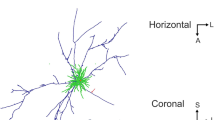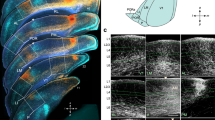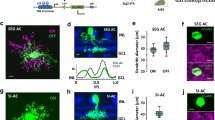Abstract
The classical neuro-ophthalmologic literature describes the organization of the primate's optic tract as containing a single topographic representation of the complete contralateral visual hemifield1–4. In contrast, cats have separate visual field representations for the optic axons of the functionally distinct retinal ganglion cell classes5,6. As the line of decussation for each ganglion cell class in the cat occupies a different location on the retinal surface7–11, whereas in primates they are all superimposed12, such a species difference might be expected. We report that implants of horseradish peroxidase placed in either the deep or superficial extremes of the monkey's optic tract produce retrograde labelling of distinct retinal ganglion cell classes, and produce anterograde labelling confined to distinct laminae of the lateral geniculate nucleus. Hence,the optic tract of the primate cannot contain a single representation of the contralateral visual hemifield; rather, independent visual field representations for the functionally distinct optic axons must exist. Their anatomical segregation may account for the clinical observation of selective impairments of distinct visual abilities following partial interruption of the optic tract in man13.
This is a preview of subscription content, access via your institution
Access options
Subscribe to this journal
Receive 51 print issues and online access
$199.00 per year
only $3.90 per issue
Buy this article
- Purchase on Springer Link
- Instant access to full article PDF
Prices may be subject to local taxes which are calculated during checkout
Similar content being viewed by others
References
Polyak, S. L. The Vertebrate Visual System (University of Chicago Press, Chicago, 1957).
Duke-Elder, S. System of Ophthalmology, Vol. II (Klimpton, London, 1961).
Hoyt, W. F. & Luis, O. Arch. Ophthal. 68, 124–136 (1962).
Hoyt, W. F. & Luis, O. Arch. Ophthal. 70, 113–129 (1963).
Guillery, R. W., Polley, E. H. & Torrealba, F. J. Neurosci. 2, 714–721 (1982).
Torrealba, F., Guillery, R. W., Eysel, U., Policy, E. H. & Mason, C. A. J. comp. Neurol. 211, 377–396 (1983).
Stone, J. & Fukuda, Y. J. comp. Neurol. 155, 377–394 (1974).
Kirk, D. L., Levick, W. R., Cleland, B. G. & Wässle, H. Vision Res. 16, 225–231 (1976).
Kirk, D. L., Levick, W. R. & Cleland, B. G. Vision Res. 16, 233–236 (1976).
Wässle, H. & Illing, R.-B. J. comp. Neurol. 190, 333–356 (1980).
Illing, R.-B. & Wässle, H. J. comp. Neurol. 202, 265–285 (1981).
Bunt, A. H., Minckler, D. S. & Johanson, G. W. J. comp. Neurol. 171, 619–630 (1977).
Bender, M. B. & Bodis-Wollner, I. A. Neurol. 3, 187–193 (1978).
Leventhal, A. G., Rodieck, R. W. & Dreher, B. Science 213, 1139–1142 (1981).
Perry, V. H. & Cowey, A. Expl Brain Res. 43, 226–228 (1981).
Perry, V. H., Oehler, R. & Cowey, A. Neuroscience 12, 1101–1123 (1984).
Rodieck, R. W., Binmoeller, K. F. & Dineen, J. J. comp. Neurol. 233, 115–132 (1985).
Perry, V. H. & Cowey, A. Neuroscience 12, 1125–1137 (1984).
Reese, B. E. & Guillery, R. W. J. comp. Neurol. 260, 453–459 (1987).
deMonasterio, F. M. J. Neurophysiol. 41, 1394–1417 (1978).
deMonasterio, F. M. J. Neurophysiol. 41, 1418–1434 (1978).
Kaplan, E. & Shapley, R. M. Proc. natn. Acad. Sci. U.S.A. 83, 2755–2757 (1986).
Schiller, P. H. & Malpeli, J. G. J. Neurophysiol. 40, 428–445 (1977).
Schiller, P. H. & Malpeli, J. G. J. Neurophysiol. 41, 788–797 (1978).
Walsh, C. & Guillery, R. W. J. Neurosci. 5, 3061–3069 (1985).
Walsh, C. & Polley, E. H. J. Neurosci. 5, 741–750 (1985).
Walsh, C., Polley, E. H., Hickey, T. L. & Guillery, R. W. Nature 302, 611–614 (1983).
Hanker, J. S., Yates, P. E., Meltz, C. B. & Rustioni, A. J. Histochem. J. 9, 789–792 (1977).
Perry, V. H. & Linden, R. Nature 297, 683–685 (1982).
Mesulam, M.-M. J. Histochem. Cytochem. 26, 106–116 (1978).
Olucha, F., Martinez-Garcia, F. & Lopez-Garcia, C. J Neurosci. Meth. 13, 131–138 (1985).
Author information
Authors and Affiliations
Rights and permissions
About this article
Cite this article
Reese, B., Cowey, A. Segregation of functionally distinct axons in the monkey's optic tract. Nature 331, 350–351 (1988). https://doi.org/10.1038/331350a0
Received:
Accepted:
Issue Date:
DOI: https://doi.org/10.1038/331350a0
This article is cited by
-
Macular oscillatory potentials in humans
Documenta Ophthalmologica (1990)
Comments
By submitting a comment you agree to abide by our Terms and Community Guidelines. If you find something abusive or that does not comply with our terms or guidelines please flag it as inappropriate.



